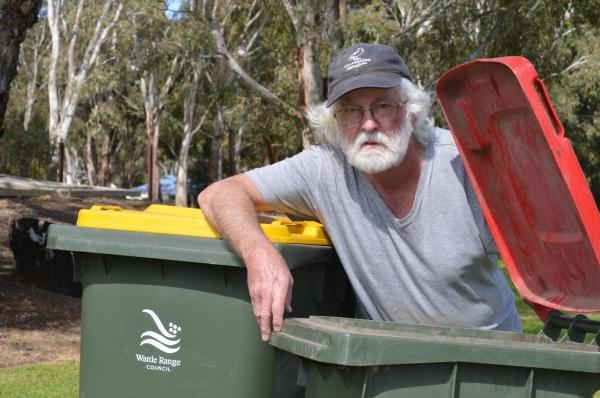
By Raquel Mustillo
KALANGADOO, Mount Burr and Nangwarry residents could have the contents of their kerbside bin examined to reduce contamination and properly sort and clean recyclable material.
A Wattle Range Council climate change committee has supported the investigation into a bin tagging project which will involve visual rubbish bin inspections of selected households in areas where there is a large problem with inappropriate waste in red bins.
The scheme, has been credited for decreasing contamination in one metropolitan council by 66pc, would rely on council staff or volunteers to inspect bins prior to the rubbish pick up.
Data for each household is collected based on the visual assessment and then a coloured tag is placed on the bin – red for serious contamination, orange for mild contamination and green for no contamination – to provide individualised feedback about the content of the bin.
Currently, Wattle Range Council’s waste contractor Veolia uses trucks fitted with video cameras to monitor waste, with individuals found to have disposed non-recyclable material in recycling bins issued a ‘contamination’ letter.
Engineering Services director Peter Halton said committee members had discussed the potential of adopting a scheme where contamination was identified prior to the contents of the bin being emptied.
Mr Halton said council staff were investigating the logistics and costings of rolling out the bin tagging program across Wattle Range before the item is considered by the committee and council.
“It will need a bit of due diligence before we stick it back in front of council and that will include things like service costs, pros and cons and risks and challenges,” he said.
“It certainly has some benefits, it certainly has some logistical challenges and cost implications, but on the flipside, we are paying for the cost of contamination both in our loss of recycling material that’s going to landfill as well as paying for contaminated items going to recycling facilities.
“Not all costs will be financial, some of those are environmental costs and that’s another consideration.
“At the moment it costs more to dispose of recyclable material at a recycling facility than to landfill, but where we’re not saving the community’s hip pockets, we’re trying to look after the environment.”
Mr Halton said rolling out the program across councils’ smaller towns was not in response to higher levels of contamination but said trialling the program would be easier in locations with lower population rates.
“There’s no doubt when we have done recent audits there are pockets within towns that are worse than other areas, but when you want to roll out a program like this you want to roll it out across an entire town,” he said.
“Doing an audit in that form in a big town like Millicent would be challenging just because of the number of residents.
Kalangadoo resident Peter Savage supported the proposal, saying a visual tag proving information to residents on how they can better recycle would encourage compliance.
“I thought people would have been used to the different coloured bins for different items by now and it surprises me that people are not aware of the uses and the guidelines,” he said.
“I can’t see where people go wrong with putting the wrong thing in their bins, unless people are doing it deliberately, which they might do.
“I think it would make people change their ideas and start putting the right items in the right bins.”
Mr Savage was not concerned about the bin audits, but acknowledged some residents could view the approach as council intruding on their privacy.
“There’s no invasion of privacy as far as I can see and if people end up being proactive about what they put in their bin, that’s good,” he said
“But there may be some people who would not want other people to know what they have in their bins.
“I couldn’t care… the contamination is more of a worry.”
HAVE YOUR SAY – editorial@tbwtoday.com.au







